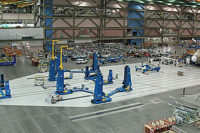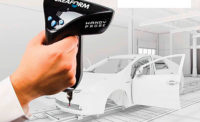Airplanes old and new share many of the same types of components. One is a nacelle, or engine housing, with an inlet lip skin that ensures smooth air flow. However, not all planes have similarly shaped lip skins. Many have perfectly round skins, whereas the Boeing 777X and 737MAX require non-cylindrical skins.
GKN Aerospace recently contracted with Boeing to provide them with these components. All skins for the 777X are produced at GKN’s Camarillo, CA, facility, while those for the 737MAX are formed at the company’s Orangeburg, SC, plant.
Shortly after contracting with Boeing, GKN representatives met with MJC Engineering & Technology Inc., a machine tool builder based in Huntington Beach, CA. GKN stressed its need for a spin-forming machine that quickly and precisely produces the irregular-shaped skins. MJC, in turn, developed a machine that combines traditional spin-forming capability with advanced robotic handling and CNC technology from Siemens Corp.
The spin-forming process involves clamping a large metal sheet onto a mandrel and rotating it using servo-controlled motors and drives. After heat is applied by a gas torch affixed to a robotic arm, a roller makes contact with the sheet and forces it to flow over the mandrel surface into a desired shape.
According to Carl Lorentzen, president of MJC, each of its machines forms lip skins from aluminum sheets that are 270 inches in diameter, 0.625 inch thick and rotated on a 150-hp spindle. While heat is applied, Raytek thermal imaging cameras closely monitor the heat readings over the entire surface.
When inconsistencies are detected, the heat is appropriately adjusted in real time by controllers for the spinning machine and heating robot. The heated material is then formed to its specified shape, which is typically out-of-round by 8.5 to 9 inches. Per Carlson, vice president and general manager at MJC in Camarillo, says that heat must be precisely and consistently applied to ensure quality parts. Even the slightest variation may result in an unusable part.
“Custom screens for teach-in and playback facilitate faster commissioning and troubleshooting for the GKN operators,” explains Don Hebert, an electrical engineer at MJC. “The robot [has] 32 pre-programmed moves that are fully integrated with the heating and thermal imaging processes.”
Several Siemens products optimize machine performance. The Sinumerik 840D sl, an open CNC, controls seven axes of motion, monitors every movement between the controllers and feeds back all data for tracking purposes.
Solid Edge is the CAD program GKN uses to design the skin, while Siemens NX CAM translates the design data into machine execution steps. In addition, each MJC machine incorporates Siemens’ Sinamics drives, Simotics motors and Simatic S7 PLC technology that control various mechanisms during spin forming.
Lorentzen points out that the machine also features MJC’s Green Power hydraulic system combined with Sinamics servo pump technology. Together, they ensure that the machine uses the exact amount of hydraulic pressure needed, unlike the conventional ‘constantly on’ hydraulic pump motor manifold. The result is energy savings for GKN of up to 40 percent.
“Everyone knows that variation is the No. 1 contributor to low manufacturing yields and increased operating costs,” says Carlson. “CNC spin-formed lip skins exit the process as consistently as a stack of quarters, to draw an analogy. The improvement literally catapults a production floor to new levels of manufacturing excellence. It certainly has at GKN.”
For more information on advanced CNC technology, call 847-640-1595 or visit www.siemens.com/global.





